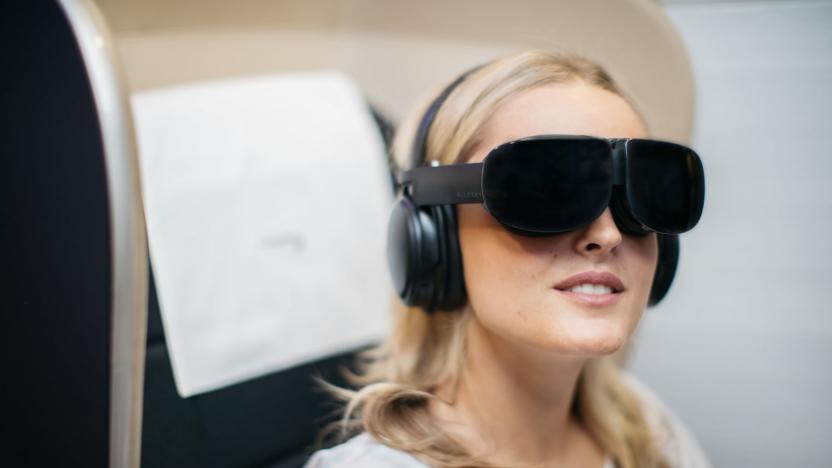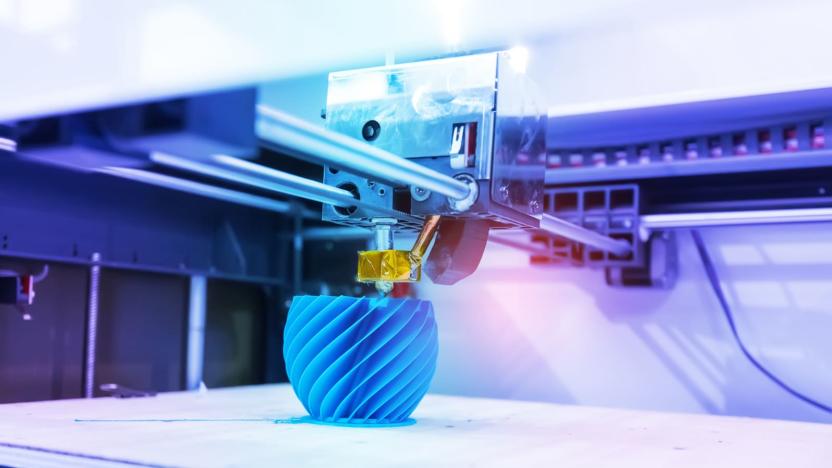3D
Latest

Snapchat makes your selfies more animated with new 3D effects
Get ready for your selfies to have a little more pop on Snapchat. Today, the company is introducing 3D Camera Mode, a new feature which lets you take Snaps that can change perspective and appearance as you move your smartphone around. To make this effect happen, Snapchat is taking advantage of Apple's TrueDepth camera system, which the Cupertino firm uses for features such as Face ID and Animojis. Naturally, this means the new 3D Camera Mode only works for Snapchatters with an iPhone X and above, although these three-dimensional Snaps can be viewed by anyone on the app. So, if you have an Android phone, you can enjoy your friends' 3D selfies, you just can't create any of your own.
Edgar Alvarez09.17.2019
Intel will use multi-camera, 3D athlete tracking in the 2020 Olympics
Intel plans to bring 3D athlete tracking (3DAT) to the 2020 Olympics. Today, the company announced that its 3DAT system will use four cameras to film athletes in the 100-meter and other sprinting events. Algorithms will then analyze the biomechanics of the athletes' movements and broadcast those as visual overlays available during replays.
Christine Fisher09.11.2019
British Airways is offering VR entertainment on flights
British Airways is set to trial VR entertainment on select first class flights from London Heathrow to New York JFK. From now until the end of the year, customers on these flights will have their own 3D cinema in the sky, and will be able to watch a variety of films, documentaries and travel shows in 2D, 3D or 360° formats.
Rachel England08.14.2019
Google's Area 120 made a free, drag-and-drop 3D game builder
Google's in-house incubator, Area 120, has produced things like an app that teaches coding and tools to boost literacy. Now it wants to help gamers create their own 3D games, no experience necessary. Today, it launched Game Builder, a free platform that aims to "make building a game feel like playing a game."
Christine Fisher06.13.2019
'Unprecedented' 3D magnetic interactions could change computing
The field of spintronics, or spin electronics, uses an electron's spin and its magnetic movement to encode instructions and other data. It's sometimes seen as an alternative to electronics, which relies on the electron's charge to encode data. While spintronics has the potential to increase data processing speeds, boost storage capacity and offer increased data resilience, it's been limited because physicists could only move the electrons -- or tiny magnetic particles -- around a single atomic layer. Now, researchers have found a way to move information from magnets in one layer to magnets in another. They hope the discovery will lead to new possibilities for data storage and computing.
Christine Fisher06.03.2019
Logitech's new stylus is built for VR
Architects, product designers and concept artists just got a ground-breaking new tool in their creative arsenals: Logitech's VR Ink Pilot Edition, the world's first VR stylus that draws on both two-dimensional surfaces and in the air in three-dimensional room-scale spaces. Unlike previous iterations of similar technology -- usually unwieldy controllers -- this stylus puts all the power in the designer's fingertips for complete precision and accuracy.
Rachel England05.29.2019
One of these models doesn't exist
Virtual humans are gradually scaling the uncanny valley, and like artificial intelligence, they're coming for our jobs. A case in point is Imma, a digital Instagram model who has garnered over 50,000 followers thanks to her (its?) trendy, street-style selfies and photos. Imma just entered uncharted territory for 3D rendered humans, appearing in a makeup spread with two real models for Kate cosmetics in Vice's i-D site in Japan.
Steve Dent05.22.2019
Watch the trailer for Ang Lee's 120 fps film 'Gemini Man'
We knew Will Smith was preparing to fight a younger version of himself in the upcoming Ang Lee sci-fi film Gemini Man. Now, thanks to the trailer released today, we get a glimpse of what that will look like. The two-minute clip shows present-day Smith as Henry Brogan, an elite but aging assassin who's being chased by a younger clone. Visual effects -- similar to those that allowed Samuel L. Jackson to digitally de-age in Captain Marvel -- will make it possible for Smith to play both roles.
Christine Fisher04.23.2019
Shampoo magnate uses glasses-free 3D to push budget phones
Remember how shampoo magnate John Paul DeJoria threw himself into the mobile world five years ago? He's now offering smartphones -- and they might be appealing if you find most budget phones a little boring. Rokit's newly launched Io 3D and Io Pro 3D (above) both offer glasses-free 3D without the expense that usually comes with the tech. You won't need to go to the length of buying a RED Hydrogen One just to bedazzle your friends. There's even an "expansive" catalog of content to watch through an app that that hosts movies and other stereoscopic material.
Jon Fingas03.21.2019
Light waves allow scientists to 3D print with multiple materials
3D printing can already create sensors for NASA rovers, rocket engines, safer football helmets, dentures. Name it, and it seems like it can be 3D printed. But the technology is still pretty limited, partly because most 3D printing systems can only make parts made of one material at a time. Now, researchers at the University of Wisconsin have discovered a way to use light to 3D print with more than one material.
Christine Fisher03.13.2019
NVIDIA will stop supporting 3D glasses in April (updated)
Have you noticed that stereoscopic 3D is out of vogue, at least at home? So has NVIDIA. The graphics chip designer has unveiled plans to drop support for 3D Vision, its approach to gaming with 3D glasses. The last drivers to support 3D Vision will come with the final Release 418 in April, with future versions dropping it entirely. You'll still get support for "critical driver issues" in 418 through April 2020, but you'll otherwise need to move on.
Jon Fingas03.11.2019
Apple quietly bought Lighthouse's AI home security camera patents
When Lighthouse's intelligent security camera finally went on sale just over a year ago, the company believed that with AI recognition and 3D sensing technology, it offered something truly unique over its rivals. However, the promise of automatic face detection didn't really resonate with consumers, and the hardware maker shut down less than 10 months later. While the company slipped quietly into the night, its technology didn't, with none other than Apple ghosting in to acquire its innovations.
Matt Brian03.05.2019
Bringing the wonder of old-school survey maps into three dimensions
Mapping technology is infinitely better than it used to be, but satellites and LiDAR can never recapture the craft that went into making old-school US Geological Survey Maps. Instead, graphic designer Scott Reinhard is trying to bring a modern touch to the old designs using 3D technology. He used elevation data from the United States Geological Survey to create 3D elevations of the topography, then merged the data with the vintage designs of the old maps.
Steve Dent02.10.2019
Red teases 'Lithium,' a 3D camera for its Hydrogen One phone
At $1,300, RED's Hydrogen One smartphone was never really aimed at consumers, so now it's starting to reveal a strategy for its bread-and-butter pro cinematographer market. On Facebook, it showed off "Lithium," a 3D camera that essentially uses the Hydrogen One as a monitor and controller. "Big things in the works for next for next year: Lithium," said the caption, with no other information.
Steve Dent01.03.2019
Fox Sports’ new virtual studio runs on Unreal Engine
It's no secret that Epic Games has enabled a number of gaming studios to create more-realistic visuals with its Unreal game engine. Since its debut in 1998, powering the first-person shooter Unreal, the technology has evolved to power hundreds of games, from Fortnite to Street Fighter V, and with that process, the virtual has become increasingly more realistic. Now in its fourth iteration, Unreal Engine is no longer exclusively being used for gaming, as other industries have taken notice of the possibilities. Unreal Engine 4 has become a key element for film and television in recent years, and Fox Sports is using it to power its new, completely virtual studio set. "Virtual sets have been around for quite some time, and we've done our fair share of using them," Zac Fields said. "But it's always been a struggle to give that sense of photo realism." Fields oversees Fox Sports' Graphic Technology and Integration department, which includes the addition of new gear during a studio build. He said the team started thinking about the idea of a virtual set about two years ago. Around 15 months ago, the network started getting staff familiar with the software and began tests. Then last winter, the broadcaster did a virtual show. Fields described this as a "full run-through" of a show on the virtual set that was built in Charlotte, North Carolina.
Billy Steele10.16.2018
Oculus Medium is becoming a better VR sculpting tool
With the next version of Medium, the immersive VR sculpting tool for the Rift, Oculus is giving users exactly what they're asking for. That includes long-awaited features like grid snapping (below), up to 100 layers and the ability to add more than one light. Medium is similar to Google's Tiltbrush, except it's focused on creating 3D objects, not entire scenes. Another useful addition: You can now send your 3D sculptures directly to your Oculus Home virtual living room.
Devindra Hardawar06.28.2018
AMC's 'Stubs A-List' subscription is a direct attack on MoviePass
That took.... longer than expected: To compete with MoviePass, AMC Theaters will launch a monthly subscription service starting June 26th. With the AMC Stubs A-List program, in exchange for $19.95 per month folks will be able to see three movies of their choosing per week -- even if that means seeing the same movie three times in the same day. According to a press release, this also includes IMAX, Dolby Cinema and 3D features. You can buy tickets day-of or weeks in advance, too, using either the AMC website or mobile app.
Timothy J. Seppala06.20.2018
Scientists create the first 3D-printed human corneas
Newcastle University researchers have devised a groundbreaking experimental technique that could help millions on the corneal transplant waiting list. By using a simple 3D bio-printer, Professor of Tissue Engineering Che Connon and his team of scientists were able to combine healthy corneal stem cells with collagen and alginate (a type of sugar sometimes used in tissue regeneration) to create 'bio-ink' -- a printable solution that enabled them to reproduce the shape of a human cornea in just 10 minutes.
Katrina Filippidis05.30.2018
RED is building an 8K 3D camera for its holographic phone
RED is partnering with a company called Lucid on an 8K, 3D prosumer camera that will work with its incoming Hydrogen One smartphone, Lucid announced. The device -- shown above in prototype form at RED's Hydrogen One party -- has two synced 4K cameras that capture and convert video and images to 8K 4V (.h4v) files. Those can then be displayed in 3D on the Hydrogen One's "holographic" display, and later uploaded to YouTube, Facebook and RED's own content hub.
Steve Dent05.22.2018
AI offers a new way to look inside living human cells
Over the course of their careers, biologists develop a huge mental library of cell structures and their corresponding data. Investigating specific areas of a living cell involves a piecemeal approach, identifying how some parts work with others and spending time on cell labelling. But now, the Allen Institute for Cell Science has launched the first predictive 3D model of a live human cell -- the Allen Integrated Cell -- and it could be "a total game changer", according to researchers.
Rachel England05.10.2018